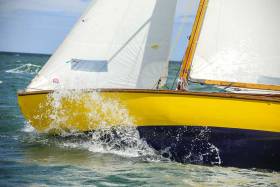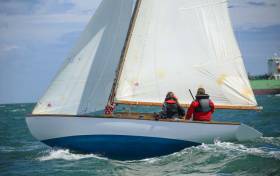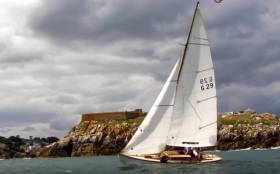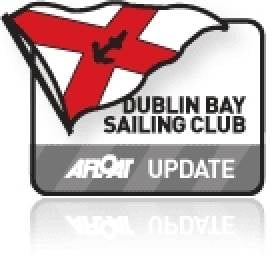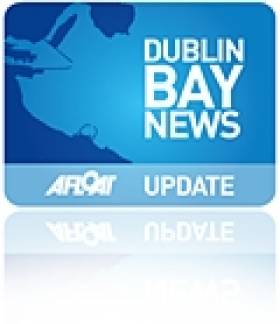Displaying items by tag: Glen
New Life For Ireland’s Ancient Local Classes As Top Sailors Learn to Value Neighbourhood Sport
They’ve been part of our sailing furniture for so long that you could be forgiven for thinking Ireland’s historic local classes might just quietly fade away through being barely noticed. But you’d be very much mistaken. 2023 has been a season in which these special boats, and the quality sport they provide, have come to be seen in an ever more appreciative way.
For sure, in times past, each class would have its blindly faithful little group of adherents, who would refuse to consider any other sort of boat. But in recent years, the significant shift has been in the attitudes of support from sailors with experience in other craft – often many other craft - right up to the top international level.
TEDIOUS LOGISTICS OF INTERNATIONAL SPORT DIMINISH ITS ATTRACTION
Jaded perhaps by the increasing stress of international travel, and by the fact that the reasonably popular international sailing venues of yesteryear are now over-crowded places which have become far too busy for their own good, they have been taking a fresh look at the sport to be had in their home place, where their own journeys afloat began in boats which their fathers and uncles might have sailed.
 Shannon One Designs in a stiff breeze on Lough Derg. One of Ireland’s many local classes which have recently passed a significant waypoint, they celebrated their centenary in 2022
Shannon One Designs in a stiff breeze on Lough Derg. One of Ireland’s many local classes which have recently passed a significant waypoint, they celebrated their centenary in 2022
And they find that what they previously took for granted is something to be cherished, appreciated and enjoyed as a source of a very special sort of sport, a true community endeavour where a meaningful role and sense of participation is found for crews of all levels of competitive talent.
CONGENIAL NEIGHBOURHOOD CLUBS
The fact that in most cases in Ireland, this ready sport afloat is to be found just down the road in the congenial neighbourhood club means that returning international hotshots have to learn to ease off a bit on their game. It’s a sort of unwritten rule which has meant that the most diligent application of the written rules tends to be undertaken by class veterans who may even – dare one say it – have something of a vendetta going back many years against another boat. That’s how it can go in local racing.
 Senior citizens. The Mylne-designed Strangford Lough River Class celebrated their Centenary in 2020. They are believed to be the world’s first One-Design class to have set Bermudan rig when new
Senior citizens. The Mylne-designed Strangford Lough River Class celebrated their Centenary in 2020. They are believed to be the world’s first One-Design class to have set Bermudan rig when new
MULTIPLE ANNIVERSARIES
This refreshed interest in local classes has been further energised by a slew of special anniversaries. The handsome yet hefty River Class sloops on Strangford Lough celebrated their Centenary in 2020, in 2022 the Shannon One Designs were on their energetically-celebrated One Hundred while the 25ft Glen Class in Strangford Lough and Dun Laoghaire marked their 75th, and in 2023 the Howth Seventeens have been marking their 125th year in an inspired programme led by Class Captain David O’Shea, while the 18ft Belfast Lough Waverleys have celebrated their 120th at their new base with Strangford Lough YC at Whiterock, which bids fair to become Classic Classes Central with the Rivers and Glens already well established in the bay.
 “Slipping effortlessly along” – whether it’s Belfast Lough or Strangford, the 18ft Waverley keelboats have a fine performance which belies their workaday looks
“Slipping effortlessly along” – whether it’s Belfast Lough or Strangford, the 18ft Waverley keelboats have a fine performance which belies their workaday looks
WAVERLEY “HOMECOMING”
And as it happens, in a sense it’s a homecoming for the Waverleys, for although the class originated in 1903 with the County Antrim Yacht Club at Whitehead on Belfast Lough, in the two or three years before World War I in 1914 five boats to the design raced on Strangford, with all of them named for seabirds. When the Strangford class failed to revive after the War, they were all bought up for Belfast Lough racing and allowed to join the Waverley Class provided that, like their sister-ships, they took new names from Walter Scott’s Waverley novels.
 New life for an old boat – Waverley Class as restored by Ricky le Boas of Ardglass, who has also “worked magic” on boats of the Glen Class from both Strangford Lough and Dublin Bay
New life for an old boat – Waverley Class as restored by Ricky le Boas of Ardglass, who has also “worked magic” on boats of the Glen Class from both Strangford Lough and Dublin Bay
 The reviving Dublin Bay 21 Class colour scheme – work is now under way with Steve Morris of Kilrush on the fifth boat to be restored, with just two more to be done to complete the class
The reviving Dublin Bay 21 Class colour scheme – work is now under way with Steve Morris of Kilrush on the fifth boat to be restored, with just two more to be done to complete the class
At the same time, classes such as the Dublin Bay 21s – with Oola, the fifth boat of the original seven now in full re-birth process with Steve Morris of Kilrush in the Hal Sisk/Fionan de Barra class revival – have seen their 120th spread over both 2022 and 2023, while of course Dun Laoghaire is mother to them all with the enduringly-popular and increasing 1887-founded Water Wag ODs.
 The 1887-originating Dublin Bay Water Wags have been able to carry their late afternoon Wednesday racing into the Autumn, as seen here on September 6th 2023
The 1887-originating Dublin Bay Water Wags have been able to carry their late afternoon Wednesday racing into the Autumn, as seen here on September 6th 2023
NEW TURN IN FAIRY CLASS STORY
There has been another celebration around the 120-year-mark for the 23ft Linton Hope-designed, John Hilditch of Carrickfergus-built Fairy Class sloops at their Cultra base on Belfast Lough with Royal North of Ireland YC.
But they have also seen an intriguing turn of fortune. The Brien family of RNIYC may be best known as International Dragon Class racers to the highest level with boats called Kin. But more recently, they’ve come to appreciate the fascinating quality of sport and camaraderie which is provided at home by the Fairy Class.
Yet although sail numbers in the class at Cultra ran to 15, the sometimes rugged weather of Belfast Lough and its exposed anchorages had reduced the number of viable boats to eleven. So when the trio of Mark Brien, Ed Cody and Mark Hunter felt they wanted to join a thriving class whose busy existence is continually chronicled by class honorary secretary, records keeper, historian and diarist David “Brick” Livingston, they looked to Lough Erne where a second branch of the class was established five years after the Belfast Lough division.
The two classes once raced together as one designs on Lough Erne some time around 1911, when the Belfast Lough division made a special inland voyage west via the Lagan Navigation, the Lagan Canal, Lough Neagh, the River Blackwater and the Ulster Canal to Lough Erne, despite which they still found the energy to take on the Fermanagh crews. But there has been a slight parting of the ways since, with the Belfast Lough boats up-dating to Bermudan rig while the Lough Erne boats stayed with the original long-boom gunter rig which required a longer bowsprit to maintain helm balance.
 The Fairy Class on Lough Erne retained the original gunter rig
The Fairy Class on Lough Erne retained the original gunter rig
BELFAST LOUGH CLASS THRIVES, LOUGH ERNE WANES
However, while the Belfast Lough class has thrived mightily in recent years to become trendy, the Lough Erne division was becoming moribund in the face of demand for crews from the likes of the J/24 class. Nevertheless it must have required some delicate diplomacy for Mark Brien and his colleagues to persuade them down in Fermanagh that the best future for the rather tired Fairy OD Snipe was in a completely restored form, and re-rigged as a Bermudan sloop with a shortened bowsprit to become Belfast Lough Fairy Class Number 16, the first time the Cultra division has reached that registered fleet size.
 New rig, new life – the former Lough Erne Fairy Class Snipe – now No 16 - makes her public debut at Holywood Regatta on Belfast Lough on September 2nd
New rig, new life – the former Lough Erne Fairy Class Snipe – now No 16 - makes her public debut at Holywood Regatta on Belfast Lough on September 2nd
The restoration proved to be a massive job which is fascinating for classic boat enthusiasts and any appreciators of quality workmanship, so we’ll be carrying a more detailed and fully-illustrated account in a future Afloat.ie. But meanwhile it meant that Snipe in her latest manifestation did not take to salt water for the first time in her 115 years until late in the 2023 season, and in fact her public debut was at Holywood Yacht Club Regatta on Saturday, 2nd September.
The setting could not have been more appropriate, as its drying nature means Holywood is a genuinely spectator-friendly regatta, as they can only race for an hour or two either side of high water - thus bringing the boats right inshore – while the club itself is the oldest on Belfast Lough, going right back to 1862. So it is allowed that Snipe got herself on the podium this time round, provided her crew realised that it wouldn’t be best for the class to make an unbroken habit of it.
Meanwhile in Strangford Lough the Waverlies had staged their 120th officially in a day of such awful weather in August that they used the gentler conditions of September 2nd for another race which was won by Nigel (Finn & John McCabe) in the happy presence of former owner Jimmy McKee of Ballyholme, whose good works on behalf of Ballyholme YC, the GP14 Class and the Waverleys have deservedly received national recognition.
 The immaculately maintained Waverley Class Nigel (Finn & John McCabe) took the honours in the class’s 120th Anniversary celebrations at Whiterock
The immaculately maintained Waverley Class Nigel (Finn & John McCabe) took the honours in the class’s 120th Anniversary celebrations at Whiterock
Unlike the Fairy Class, the Waverlies have all reverted to the original John Wylie-designed gunter rig, but their Bermudan rig did allow for the convenience of easy roller reefing, which Kevin & Colm Mac Laverty and Mick Clarke carried when they sailed Durward round Ireland in 1961. Now, however, in the ownership of Steve and Anne Allen, she is guntered.
SHANNON ODs REVERT TO PRIVATE LIFE AFTER PUBLIC EXUBERANCE OF CENTENARY
Sliding gunter rig has always been the rig of choice for the Shannon One Designs and the Dublin Bay Water Wags. And while the former have reverted to the anonymous totally private parallel existence on the Shannon Lakes which they exuberantly abandoned last year for their Centenary, the word is that Andrew Mannion and David Dickson have been the helmsmen who have been showing in front during 2023’s recuperative season.
As for the Water Wags, as the weekly reports have been indicating in Afloat.ie all season, the class has been so healthy that many have been taking a win. It will be interesting to see how this ultimate local class, with its remarkable mixture of down-home sailors and international stars to Olympic level, will shape up during their regatta visit to Lough Key on the Upper Shannon area in a week’s time.
 Undoubtedly August 2023…..Mermaids racing in their Nationals at Skerries with a sky that looks beyond threatening
Undoubtedly August 2023…..Mermaids racing in their Nationals at Skerries with a sky that looks beyond threatening
Staying more local in their ambitions were the Dublin Bay Mermaids, now found racing only at Foynes on the Shannon Estuary, and Rush and Skerries in Fingal, with the latter providing weather which was truly Wagnerian for 2023’s annual championship at the beginning of August. Yet a winner emerged in the form of This Is It (No 177), sailed by Mark Boylan, Aileen Boylan, and Colman Grimes, whose personal contribution to sailing both in Skerries and nationally is the stuff of legend.
 International Umpire Ailbhe Millerick’s superbly-restored Glenluce racing in the kind of conditions that Dublin Bay can provide when the going is good
International Umpire Ailbhe Millerick’s superbly-restored Glenluce racing in the kind of conditions that Dublin Bay can provide when the going is good
Meanwhile, the Glen Class section in Dun Laoghaire may seem like just another local class, but its ranks include international offshore racing owner-skipper Adrian Lee, and International Umpire Ailbhe Milllerick, whose personal restoration of Glenluce was and is a wonder to behold.
They may well have unwritten rules about what the usual far-ranging post-race chat can encompass. After all, an International Umpire will have a juicy story or two. And though other local classes in Ireland can claim national and world champions, and Olympic medallists too, only the Dun Laoghaire Glens can claim the first-ever winner of the RORC Caribbean 600 Race in the person of Adrian Lee.
Glenluce Wins Glen Round the Dalkey Island Race for the Bobolink Trophy
Six Glens lined up to start at a very busy Dun Laoghaire harbour entrance and took off in sunshine and a 10 knot westerly running down to Dalkey Island on Dublin Bay with the ebb tide beneath. All were vying for the Bobolink Trophy.
Yellow boats Glenshesk and Glendun were first up with Spinnakers inside in the pack with Glencoe, Glendun, Pterodactyl and Glenroan; Glenluce hoisted further outside. The inside group on the back of the East Pier got the jump initially with Glenshesk emerging in the lead. Glencoe eased out into clearer air and Glenluce's outside passage in the breeze started to pay off giving her a slim advantage.
Across Scotsman's Bay, Glenshesk sailing inside to the Forty Foot pulled further ahead of the fleet abeam of Glenluce. The wind headed and Glenshesk looked strong in the Bullock race 10 boat lengths ahead but alas was to get hung up in the doldrums behind the Bullock Rock. Glencoe in clearer air pulled ahead of her. Pterodactyl and Gleanroan avoiding the Bullock lee were tracking Glencoe. Outside Glenluce pulled ahead getting the advantage from the puffs off the land. At the Maiden Rock, Glenluce hauled sheets and dropped the kite to enter the sound opting for the two-knot tide to carry her through the fickle wind there. Glencoe was by now just 10 boat lengths astern.
 Glenshesk (Mike Reid, Liz Faulkner, Niamh Strathern) were third in the Dalkey Island Race
Glenshesk (Mike Reid, Liz Faulkner, Niamh Strathern) were third in the Dalkey Island Race
Pterodactyl and Glenroan opted to leave the Maiden Rock and the Island to starboard. The fleet compressed in the sound and Glenluce broke free hoisting her spinnaker again to round the east end of the Island meeting Pterodactyl and Glenroan head-on at the halfway point, the opposing boats dousing their spinnakers simultaneously for the beat home against a slackening tide. Second around from the inside passage was Glencoe leading Glenshesk and Glendun. Pterodactyl & Glenroan faced a fickle Dalkey sound with a foul tide home and hadn't past Glenmillers (Conor O'Hanlon's) house as the rest of the fleet fetched past north of the Maiden Rock.
Glenluce's escape assured her of free passage home as the lifting breeze made it a fetch to Dun Laoghaire piers with no way back for the pursuing fleet.
Round the Dalkey Island Race for the Bobolink Trophy Results
- Glenluce - Ailbe & Aidan Millerick Dermot Bremner
- Glencoe-Rose Marie Craig (First Bobolink Lady helm) Pat Sheehan et al.
- Glenshesk Mike Reid, Liz Faulkner, Niamh Strathern.
The Resurgent Glen Keelboat & Why Local One Design Sailing Classes Have Never Been More Relevant
The cherished local One-Design classes of Ireland have never been more relevant than they are now, in these crazy times of soaring-graph numbers when local is good. The expectation of staying local, while making do with fairly modest socialising and sporting ambitions, is proving to be the ideal way to avoid having to go through more travel hassle than the eventually-achieved broad-scope socializing event or sporting competition is worth.
Admittedly there are those for whom "staying local" in Ireland has now come to encompass the entire island. And beyond that there are those who have suddenly rediscovered their dormant sense of being European, which apparently can only be assuaged by a highly-monitored endlessly bothersome journey to some southern sun-spot.
But with summer settling in over Ireland for the next few days at least, local sailing is in the ascendant. And the historic neighbourhood classes are blossoming, with the Water Wags in Dun Laoghaire (originally founded 1887) on the cusp of achieving their first-ever turnout of forty boats racing at once, while across Dublin Bay the 1898-founded Howth 17s are pushing towards a cracking turnout of 20 boats regularly racing.
Meanwhile up on Strangford Lough the handsome 28ft 6ins sloops of the River Class are celebrating their Centenary in style with all of the 12 boats ever built to the design currently in full commission, and a really handsome, informative and well-illustrated history of the class by James Nixon has been published to help the celebrations along (and yes, he is the brother, but the book really is super).
 Graham Smyth's Enler, Strangford Lough River Class Centenary Champion. Photo: W M Nixon
Graham Smyth's Enler, Strangford Lough River Class Centenary Champion. Photo: W M Nixon
In fact, Strangford Lough, where the majority of all boats still lie to swinging moorings, is ideal for the classic local and inevitably engine-less classes, as such craft never seem comfortable in the confines of a marina berth even if skilled crews have long since learned how to access pontoons under sail only.
Thus although surprise has been expressed at our recent report by Betty Armstrong of the news that the surviving 18ft Belfast Lough Waverley Class boats of 1903 are planning an experimental year based at the Rivers' home club of Strangford Lough YC at Whiterock, it's an idea which makes sense. And for those who seek even the smallest historical link, the word is that in 1913 two Waverley boats were built for Strangford Lough owners, but the arrival of World War I in 1914 delayed their regular commissioning, and by the time peace returned the only people interested in sailing them were involved with the Belfast Lough fleets at Whitehead and Ballyholme.
 The Strangford Lough YC anchorage at Whiterock looking north across Sketrick Island towards the Down Cruising Club base at Ballydorn. The majority of boats based in Strangford Lough lie to swinging mooorings, while its extensive sheltered sailing waters make it ideal for classic boats to thrive.
The Strangford Lough YC anchorage at Whiterock looking north across Sketrick Island towards the Down Cruising Club base at Ballydorn. The majority of boats based in Strangford Lough lie to swinging mooorings, while its extensive sheltered sailing waters make it ideal for classic boats to thrive.
And therein we find the nub of the matter. Classic boats are merely vehicles, even if they're fascinating and often beautiful creations. But they're ultimately only bundles of lumber and metal unless they retain the strong interest of a viable group of people with enthusiasm and a strong sense of community, people genuinely keen on sailing them, and interested moreover in the quietly continuing effort of keeping the class association in a thriving state of health.
The vital role of regular racing is something that will be immediately obvious to any Irish club sailor, even if classic yacht enthusiasts elsewhere can sometimes be a bit sniffy about it. They tend to think that the preservation and genteel sailing of their historically significant pride-and-joy should be sufficient reward in itself.
But such has been the continuity of some classes in Ireland that everyone is well aware that – originally - far from being classics-in-the-making, they were simply built in economy-style to meet perceived local needs. And top of the list in those needs was sport - and it still is. In fact, the need to involve and reward everyone taking part in the impressive local racing programme is such that a parallel handicap system is deployed in most local classes, and the class associations see it as an integral part of life afloat as it actually is - not as performance fascists might like it to be.
 The restored Belfast Lough Waverley is involved in the class's trial move for a season to Strangford Lough
The restored Belfast Lough Waverley is involved in the class's trial move for a season to Strangford Lough
 "Better than new" – Waverley with her new deck by Ricky le Boas of Ardglass
"Better than new" – Waverley with her new deck by Ricky le Boas of Ardglass
When it works, the system of local class associations works very well indeed - so much so that more modern series-produced standard boats, in trying to get a class going, hope somehow to replicate the spirit of the best local classes in their own organisations. We see good examples of this in the Flying Fifteens in Dun Laoghaire, and the GP 14s on an Ireland-wide basis.
It was four times Olympic Gold Medallist Paul Elvstrom of Denmark who pointed out the value of strong class associations. In his later sailing career, he and his daughter raced to global success in the Tornado Catamaran, but as someone who invented several useful items of boat equipment, he felt the Tornado had many flaws, and oversaw the development of an alternative.
Nearly everyone else agreed that the new Elvstrom boat was indeed superior. Yet the concept didn't flourish in the face of the Tornado's strong international class association. Thus Elvstrom ruefully concluded that not only should you have the support of a strong association as you develop a new boat, but in fact, it might be better to have some sort of energetic association in being before you even begin detailed work on the project.
Yet getting things off the ground doesn't necessarily work as a top-down project. In times past the global authority – the IYRU or ISAF or World Sailing as it is now – might introduce an international design competition for a new Olympic boat, but in the long term being an Olympic class can become the kiss of death for the boats involved. A conspicuous example came in the 1960s when they sought a new three-crew keelboat. The Soling was chosen in preference to the Etchells 22 thanks, to an element of block-voting among the Scandinavian countries. But now the Soling is no longer in the Olympics, it's only very rarely found anywhere else, if at all. Yet the Etchells 22 sails merrily on, as does another rejected Olympic keelboat, the International Dragon.
In fact, in refutation of the usefulness of the top-down approach, the only Olympic boat which can claim to have true global popularity at every level of sailing is the Laser or ILCA or whatever you're having yourself. Yet it was far from erudite committee rooms and computer banks and tank tests that she was conceived more than fifty-year ago when the Laser really and truly did emerge from a couple of quick sketches by Bruce Kirby on the back of an envelope.
On the other hand, there has been a certain amount of top-down involvement in two distinctly Irish classes, the Tony Castro-designed 1720 Sportsboat of 1994, and the more recent Phil Morrison-designed Ultime development of the National 18. In both classes – and to their eternal credit – the Royal Cork YC weighed in with tangible support, and did so with the becoming modesty of good work being done by stealth.
 The attractively innovative lines of the 25ft Glen Class, a wartime dream which emerged from the Alfred Mylne office, and are taken here from the Yachting World of July 1945. In the interests of post-war economy, the stern is a simple "sawn-off" counter, and thanks to the angle at the garboards in the way of the ballast keel it is possible to carry in-hull bent timbers right across the
The attractively innovative lines of the 25ft Glen Class, a wartime dream which emerged from the Alfred Mylne office, and are taken here from the Yachting World of July 1945. In the interests of post-war economy, the stern is a simple "sawn-off" counter, and thanks to the angle at the garboards in the way of the ballast keel it is possible to carry in-hull bent timbers right across the
Nevertheless, there's no single golden rule for the success of a class – local, national or global. For a long time one of the most successful local classes in Dun Laoghaire was the 25ft Glen One Design, which originated in Belfast Lough to an Alfred Mylne design in 1947, and by the late 1950s – having already spread to Strangford Lough – was then beginning to appear in Dun Laoghaire.
 Busy times – a poster from 1951. Courtesy Dun Laoghaire Glen Class
Busy times – a poster from 1951. Courtesy Dun Laoghaire Glen Class
Soon there was a thriving class, and even after the harbour was re-shaped around the turn of the century, the Glens were well set up, as they retained their own anchorage close in off the Royal St George YC, which had been the focal point for the class from its earliest racing days in the harbour as additional boats were brought in from the north.
I remember doing the overnight delivery to Dun Laoghaire as an impecunious student with a Strangford Lough Glen one sunny late April evening in the early '60s. The boat was going to a Dr Cantwell, and though her name is forgotten, her seagoing ability is well remembered. For there was a very brisk sou'easter with more to come, yet with two reefs in the main and the working jib – the only jib – set, she powered along perfectly balanced, and then once we'd cleared St John's Point the sheets could be slightly eased for even better speed. The sun was coming up over The Baily as the gallant little boat swept into Dublin Bay, the job done and the crew completely coated in salt from top to toe.
 Glen Class in Strangford Lough. With two reefs in the main and the working (and only) jib set, a sister-ship proved to be a very able seaboat on passage from Strangford Lough to Dublin Bay in a brisk southeaster. Photo: W M Nixon
Glen Class in Strangford Lough. With two reefs in the main and the working (and only) jib set, a sister-ship proved to be a very able seaboat on passage from Strangford Lough to Dublin Bay in a brisk southeaster. Photo: W M Nixon
In fact, the little Glen's offshore credentials were recognized with the creation of a rather unlovely reverse-sheer offshore version called the Porpoise for racing with the Junior Offshore Group. But today it is the standard Glen as conceived in the Alfred Mylne design office in Glasgow during gaps in work on naval contracts during World War II which stirs the heart, the original outline specification having come from Arthur Clapham who ran a boatyard in the west end of Bangor on the shores of Belfast Lough on the shores of an inlet called Smeltmill Bay.
 The Glen Boatyard on the shores of Smeltmill Bay in West Bangor, seen moth-balled as Arthur Clapham eventually moved operations to Strangford Lough. Photo courtesy SLYC Glen Class
The Glen Boatyard on the shores of Smeltmill Bay in West Bangor, seen moth-balled as Arthur Clapham eventually moved operations to Strangford Lough. Photo courtesy SLYC Glen Class
Happily for future nomenclature, Smeltmill Bay was at the seaward end of a pleasant little dale called Strickland's Glen. Thus the Clapham setup was called the Glen Boatyard, and while he built other craft including the 43ft Robert Clark offshore racer Uladh which we happened upon while cruising what was then Yugoslavia in 1990, these days the long-since defunct yard is best remembered as having built around 36 Glen One Designs. It's a nice clear distinctive name with endlessly romantic naming possibilities incorporating the word "Glen", whereas I don't think the Smeltmill OD would have cut the mustard at all in the brand challenge stakes.
 The 43ft Robert Clark sloop Uladh – seen here in Croatia in 1990 – was built by the Glen Boatyard in 1946-47. Photo: W M Nixon
The 43ft Robert Clark sloop Uladh – seen here in Croatia in 1990 – was built by the Glen Boatyard in 1946-47. Photo: W M Nixon
Be that as it may, Arthur Clapham's concept for the new Glen OD fitted the post-war austerity requirements perfectly. Instead of the long and elegant but rot-prone counters of yore, she had an easily maintained sawn-off counter, the hulls were built upside down with a straightforward angle turn in the garboards in the way of the ballast keel, and the mast – carrying a very effective fractional rig without any aspirations to a genoa – was a simple box girder.
The mast may have been rather heavy, but like the boats themselves, it was all completely One Design at a time when everyone still remembered that when the Dublin Bay 25s were being built in the late 1890s, the several different builders involved were so ready to stretch measurement tolerance to extremes and beyond that they would have been more accurately described as the Dublin Bay 26 OD Class.
The first ten Glens were snapped up to be the new Royal Ulster No 1 Class, and my father and uncle secured No 8, which they named Glenoe after a sweet little place near Larne, as all the more famous Antrim Glen names from further north had already been collared.
Glenoe's intended colour scheme of pale-blue-with-slight-hint-of-green topsides with white boot-top and red anti-fouling was finally agreed after many extended family discussions around the kitchen table, and next afternoon my father on his rounds as a GP called by the Glen Boatyard, and gave the always-busy Arthur Clapham the colour-scheme selection, which he jotted down in his flustered way in a crowded notebook with the promise that the new boat would be ready for launching in a week's time.
Came launching day and the weather was perfect – a gentle southerly wind to provide smooth water on the decidedly basic slipway, yet no hint of rain. So a very extended family group went down the leafy glen to the boatyard, and there was Glenoe rigged and ready for launching at the top of the slip, resplendent in her red topsides, white boot-top, and blue bottom.
 Glenoe as she is today, being launched at Whiterock after her restoration in Ardglass. Photo: Mike Stephens
Glenoe as she is today, being launched at Whiterock after her restoration in Ardglass. Photo: Mike Stephens
As ever, my father was Master of Ceremonies by default, but to his eternal credit, this shock sighting of the complete reversal of the agreed colour scheme was handled in almost total silence. There may well have been steam coming out of his ears, but he simply turned us all around, marched us back up the road to the cars, and a week later – in decidedly unsuitable conditions with an onshore breeze - the properly coloured Glenoe was launched for the first time into a successful career which included being the top Glen in the Belfast Lough Festival Regatta Week of 1951.
She was part of the family for fifteen years, and though I didn't sail on her all that much as I was soon involved with the growing class of 14ft Insect dinghies at Ballyholme, you have to remember that children are the most conservative of creatures, and we like the significant cornerstones of our boyhood to stay exactly as we remember them.
So when I heard that a bundle of energy called Mike Stephens had taken on the restoration of the now elderly and Whiterock-based Glenoe a couple of years ago, I was nervous, as he had already used the highly-skilled services of ace boatbuilder Ricky de Bloas of Ardglass to restore the original Waverley Class sloop, and the re-born Waverley emerged as a proper little classic, but some distance in presentation from the basic boats as designed by John Wylie in 1902.
 Glenoe’s “new” deck has in fact been created from salvaged teak
Glenoe’s “new” deck has in fact been created from salvaged teak
The Glens having been so utterly basic in their original form, it was highly unlikely that the re-born Glenoe would chime with family memories. It so happened that Ricky had a store of vintage teak from a salvage yard, superb timber which had originally been used in the work surfaces of science laboratories. The wood was of such quality that when made into strips for finishing the deck, it was as good as new, an effect heightened by the use of white sealant rather then the traditional black to fill the seams. The result is impressive, but that’s not Glenoe as I knew her from very long ago.
Be that as it may, the project has contributed to the chances of reviving the Dun Laoghaire class, which was becoming tired. Glenoe turned up in her new form to race with them in the Volvo Dun Laoghaire Regatta of 2019, and not only won overall, but succeeded in demonstrating just how much life there was still to be found when a Glen was given the total re-born treatment.
This new awareness came at a time when people better known for their international achievements were acquiring a fresh appreciation of the pleasures of local sailing. Local sailing is at its purest with a local class, and though (as seen in our reports of The recent Narrows regatta at Strangford) the Glens are thriving in Strangford Lough, the class in Dun Laoghaire shows every sign of finding a much-needed new local strength.
 Glenariff and Glenosiros – both from the Dun Laoghaire fleet – in the final stages of restoration in Ardglass
Glenariff and Glenosiros – both from the Dun Laoghaire fleet – in the final stages of restoration in Ardglass
Adrian Lee and Hugh Cahill O'Brien have taken Glenariff and Glenosiros (me neither) to Ardglass and they're recently left the yard there in pristine condition, while in Dun Laoghaire itself, Ailbe Millerick (best known as an International Umpire) and Henry Roche found themselves a formidable Lockdown project with the restoration – even unto proper-job epoxy coating – of Glenluce and Gencree.
In Ailbe's case, the coating was done to the entire hull externally, and to the interior up to the topsides. Being an umpire, he has kept a diligent log for anyone who may plan something similar, but he admits to have stopped counting the hours involved when they got to a thousand.
 Glenluce's hull read for expoxy treatment, with all seams splined
Glenluce's hull read for expoxy treatment, with all seams splined
 When a Glen's interior is stripped, the way in which the amidships bent timbers can be carried right across the keelson is clearly shown
When a Glen's interior is stripped, the way in which the amidships bent timbers can be carried right across the keelson is clearly shown
 Glenluce and Glencree being restored in Dun Laoghaire
Glenluce and Glencree being restored in Dun Laoghaire
 Getting there. Glenluce on the verge of being re-born
Getting there. Glenluce on the verge of being re-born
 Glenluce newly afloat in Dun Laoghaire, finished in a style which is in keeping with the Glen Class's original concept. Photo: John Duggan
Glenluce newly afloat in Dun Laoghaire, finished in a style which is in keeping with the Glen Class's original concept. Photo: John Duggan
The result is a re-born Glen which for me captures the spirit of simplicity which those innovative junior draftsmen in the wartime Alfred Mylne office strove to create for Arthur Clapham, whose outline specifications may have needed quite a bit of deciphering in themselves in order to make any sense.
And contemplating the really fine bit of work which has resulted is a reminder of an experience which few can share: the dim recollection of being beside one's occasionally volcanic father as he realises the new boat's lovingly-chosen paint scheme has been applied precisely upside down.
 When it all becomes worthwhile. Glenluce on her way to her first win on Dublin Bay in restored form
When it all becomes worthwhile. Glenluce on her way to her first win on Dublin Bay in restored form
Terence Moran, Glen Sailor
Dublin Bay Sailing Club (DBSC) reports that Glen keeboat sailor Terence Moran died, suddenly and unexpectedly, after Tuesday night’s racing in Dublin Bay, just as his boat, Glenroan, was picking up its mooring in front of the Royal St. George Yacht Club.
DBSC has extended its sympathy to his wife, Joan, and his son Thomas. The club also shares the sadness of his boat-partner, Tim O’Sullivan, as well as that of his numerous friends in the Glen class, of which he was class captain in 2015.
The Dun Laoghaire Glen class held their annual dinner and prize giving in the newly refurbished dining room of the Royal St George Yacht Club last Saturday. Once again Richard O'Connor’s Glenluce was the outstanding trophy winner for the season.
The well attended event was treated to a showing of a new video featuring highlights of the 2016 season (below). Made over the course of the year by Ki Duong, one of the regular Glen sailors, it features amusing footage of the Glens celebrating Bloomsday.
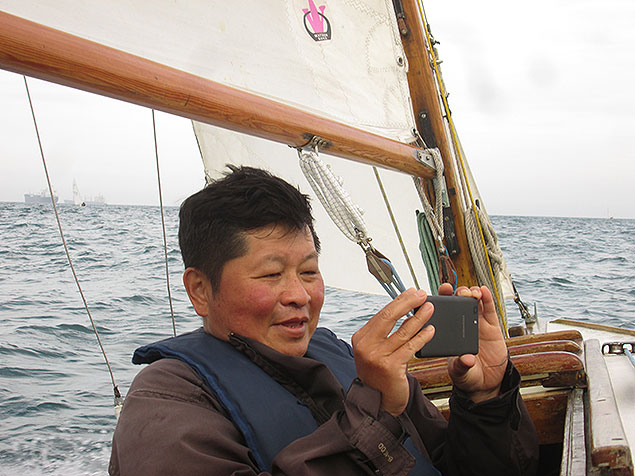 Regular Dublin Bay Glen crew Ki Duong has been documenting the class for the past six years. Watch his latest vid below
Regular Dublin Bay Glen crew Ki Duong has been documenting the class for the past six years. Watch his latest vid below
This is the sixth Glen video which Ki has posted to YouTube. It is wonderful to have this record of Dun Laoghaire’s legacy fleet available on line.
The Glen Class, under Class Captain Pete Hogan, are in rude good health going into the 2017 season with the newly restored Glenmarissa set to re-join the fleet.
Glen Class Video Shows 2015 Highlights of Dublin Bay Sailing
The Glen keelboat class video below was made by local sailor Ki Duong in action on Dublin Bay over the 2015 season. Edited in a jump cut fashion it had members of the Glen sailing community up on their feet and dancing when it was premiered at the recent Glen Dinner and prizegiving at the Royal St George Yacht Club.
As the days grow longer, Glen owners minds are turning to the annual refit and launch. After over fifty years of sailing, things are looking good for season 2016 in these classic wooden boats.
First DBSC Glen Class Race Recorded in Youtube Vid
#glen – Ki Duong, who sails on board Glenshane of the DBSC Glen keelboat class, is a keen video maker. He has produced his second Glen video featuring the first DBSC race of the season on April 23rd. Only three Glens attended although the conditions were perfect for racing. Ki was on board the winner, Glendun and this gave him ample opportunity to shoot footage of the boat he normally sails.
There is also a wonderful cameo appearance by a Moth which sort of steals the show. Tech savvy Ki is saving up for a Go Pro camera and a drone and if he ever gets them, look out Hollywood.'
Glen Sailing on Dublin Bay Video
#glen – This video, shot and edited by Ki Duong on board Glenshane of the Dun Laoghaire Glen fleet celebrates the 2014 season. The Glens have been sailing and racing on Dublin Bay now for 50 years and continue to thrive. As you can see in the video they are an ideal sized day sailer for both racing round the cans or anchoring in Killiney bay for a picnic. A real classic yacht for those who like their boats to be varnished, their sheer line to be well drawn and their keels to be full.
The class has a very active programme both on the water and socially and are always looking for new members both experienced or learner.
Glen sailing this year begins in late April and continues until September.
2015 Sailing Calendar Includes Two Bicentenaries & Ireland's Biggest Regatta At Dun Laoghaire
Irishsailing – After the remarkable across-the-board success of the 2014 Irish sailing season, 2015 will have to be very special indeed to be remembered with such enthusiasm. But it's a special year in any case, as two major sailing Bicentenaries – one in the Irish Sea, the other in the Solent – will have added and poignant meaning, as the Centenaries a hundred years ago could not be celebrated because of the First World War.
As for Irish sailing generally, life moves on, there are new sailors on the water, successful young sailors are graduating to the next stage of their rapidly developing careers, and established stars continue to plan fresh campaigns, for sailing is indeed a sport for life.
Then too, new fixtures successfully introduced in 2014 will require nurturing, tuning and encouragement if they are to fulfil their potential in the coming year, while at the same time there's always extra effort needed to give proper support to established fixtures, which have to live with the reality that they might wilt through being taken for granted. Both new and longer-established boat classes will need continued enthusiastic involvement, and our well-loved classics and traditional craft must be cherished and sailed, for lack of use is the real enemy of boats, whether old or new.
As for the major administrative initiatives introduced in 2014, they will need constant monitoring, but deserve full support from the sailing and boating community at large, for it was in response to a grass-roots initiative that the radical and very necessary reforms of the Irish Sailing Association were undertaken. Those appointed to undertake the root-and-branch reform of the national authority have done so with commendable dispatch, so it is now the duty of the rest of us to support their continuing efforts. And we can best do that by enjoying our boats and our sailing and time afloat in its myriad of interests, while encouraging others to do the same. W M Nixon outlines on what the coming year may bring.
One thing at least is certain for the coming season afloat during 2015 in most of Europe. It will not mark any significant sailing Centenaries. Instead, we are immersed in four years of remembering the Great War of 1914-1918 a hundred years on, with all the added twists of that period's longer historical narrative in Ireland. In such a context, it may seem frivolous to point out that sports like yachting have no great Centenaries to mark at all in 2015. But this minor off-screen fact is a reminder of the all-involving horror and obscenity of total warfare on an industrial scale. It obliterated anything like normal life.
Yet as recreational sailing had been going on in some sort of organised form for hundreds of years – albeit in a fairly rudimentary way in its earliest years in the 16th Century – there may well have been several important dates to be marked during the time of the Great War itself, but they were allowed to pass as there was no sport afloat, while civilian life ashore was very subdued.
And in Ireland, with the Troubles persisting for four years after the end of the Great War until 1922, the Bicentenary of the Royal Cork Yacht Club in 1920 was to be a muted affair – the official History of the Royal Cork Yacht Club (published 2005) tells us: "Plans for a special dinner to celebrate the club's bicentenary in 1920 had to be cancelled, probably because of the disturbed conditions in the country"
So the idea of celebrating the Centenary of the Royal Yacht Squadron in Cowes in 1915 at the height of the international war - other than in a rather solemn shorebound way - would have been unthinkable. But that in turn fuels the celebrations when the peacefulgood times roll again. Thus the Royal Cork Yacht Club, having been unable to celebrate its Bicentenary in 1920, went on to have a fabulous two-year Quarter Millennium celebration in 1969-70. And as the RYS couldn't have a proper party in 1915, there's no doubt that the up-coming Bicentenary in 2015 will be the nucleus of international sailing's megafest-of-the-year.
There are of course several clubs which pre-dated the Squadron when it was founded in 1815. And there are many whose members outshine the small membership of the RYS in the breadth and energy of their sailing. But for 2015, let's just acknowledge that the prestigious Squadron has been at the heart of sailing history for a very long time, while their clubhouse's location right on the Solent at Cowes is so central that when any great Solent-related events are under way, the Squadron is in the middle of the story.
Thus it was on the Squadron lawn that in July that the Irish team celebrated their epic Commodore's Cup victory at the end of July 2014. And it will be towards the Squadron and its Bicentenary that the fleet will be racing in 2015's west-east Transatlantic Race. And then it will be the firing of the cannons from the historic Squadron battery which will signal the start of the 46th Fastnet Race on 16th August 2015.
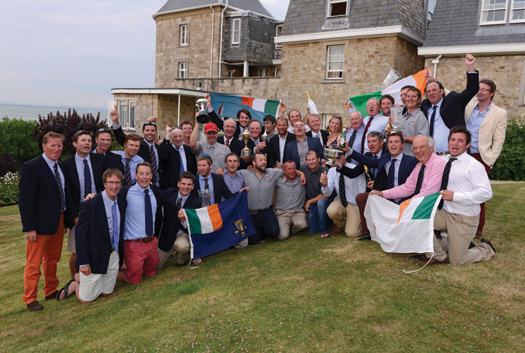
Party time at the Royal Yacht Squadron – the Irish team and their management gather to celebrate victory in the Commodore's Cup at the Squadron Castle in Cowes on August 1st 2014
There'll be many Irish boats involved, and the best-placed of them at the finish will be the winner of the Gull Salver, currently held by Martin Breen's Reflex 38 Lynx from Galway Bay SC, which was skippered to success by Aodhan FitzGerald in 2013's race. It's a coveted trophy, instituted to honour the memory of Harry Donegan of Cork and his famous cutter Gull, which was one of seven boats which inaugurated the Fastnet Race in 1925, and placed third. Since then, Irish Fastneteers have frequently been in the great race's top places, and best of all was in 2007 when Ger O'Rourke's Cookson 50 Chieftain out of Kilrush, sailing under the burgee of the revived Royal Western of Ireland YC, came sweeping in to the finish line at Plymouth to win the Fastnet Race
overall.
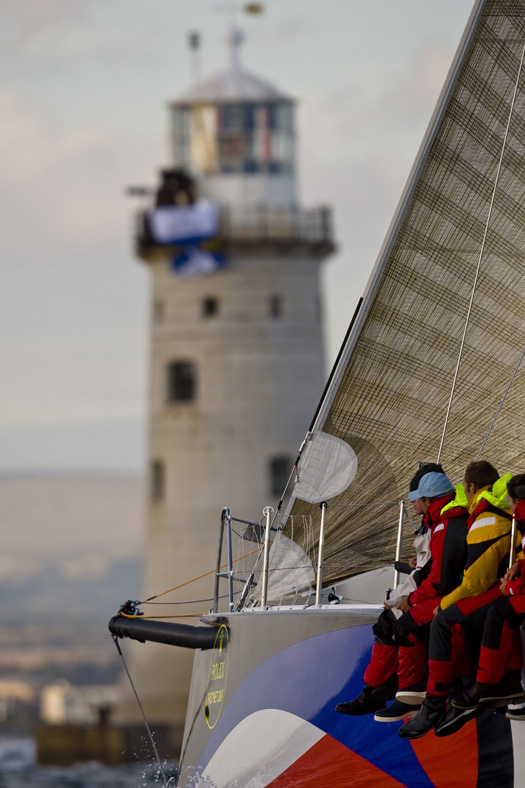
One of the greatest moments in Irish sailing history – Ger O'Rourke's Chieftain sweeps towards the finish line to become the overall winner of the Rolex Fastnet Race 2007. Photo: Rolex
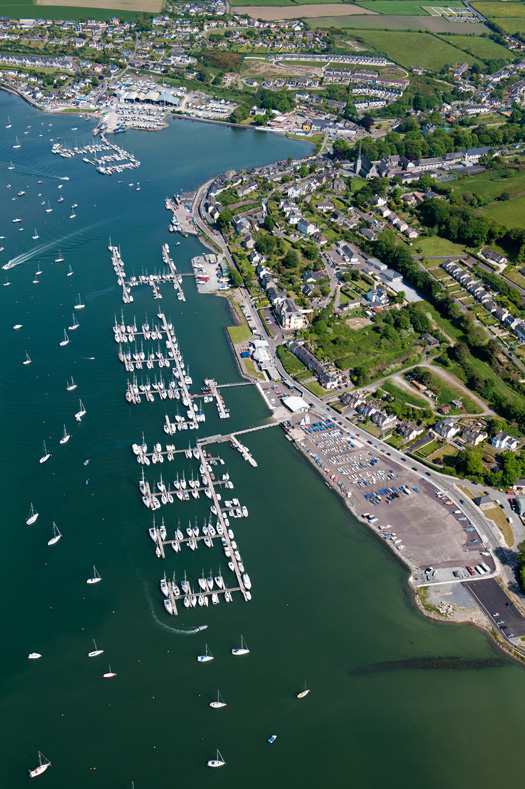
Just the spot for a great Tricentenary celebration - the very complete sailing facilities provided jointly by the Royal Cork Yacht Club and Crosshaven will become a world focus in 2020 with the Club's 300th anniversary. Photo: Bob Bateman
The realisation that 2015 sees this significant RYS Bicentenary is a timely reminder that the Royal Cork's Tricentenary is only five years down the line. They're five years which will be gone in a flash, and already behind-the-scenes moves are afoot to ensure that the national sailing programme will properly facilitate the extraordinary anniversary being celebrated in Crosshaven in 2020.
But meanwhile other Irish sailing centres have their own regular programmes to operate in the intervening four years, and in terms of numbers and scale there's no doubt the top event in Ireland in 2015 will be the biennial Volvo Dun Laoghaire Regatta from 9th to 12th July.
Anyone – and there were many - who took part in this unique "suburban sailfest" in 2013 will know that the VDLR has come of age. It's an event which is comfortable with itself while at the same time being always in development and evolution mode. Each staging of this remarkable Dublin Bay happening sees lessons being learnt and implemented even while the multi-class racing is under way on several courses. And in the two year gap before the next staging, the experience gained is closely analysed and the programme refined to further improve the sport in every area.
You get some idea of the sheer depth of racing experience in Dun Laoghaire by noting that the Chairman of the 2015 Committee is Tim Goodbody, with Martin Byrne as Vice Chairman while the Race Director is Con Murphy. And those three sailing megastars are just the peak of a mountain of race administration experience which is being drawn in from all over Ireland to ensure that the fleet of 400-plus boats gets the best sport possible.
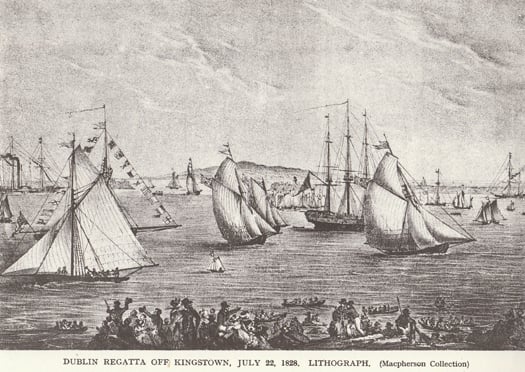
The first regatta in 1828 at the new harbour at Dun Laoghaire, which will be the setting for Ireland's biggest event in 2015, the Volvo Dun Laoghaire Regatta from 9th to 12th July.
While there'll be keenly participating boats from all over Ireland as well as Scotland, England and Wales, the setup of Dublin Bay being right on the city's doorstep means that it's the locals who would pose an administrative problem for a less experienced team. As the dates for the VDLR approached in 2013, the weather forecast steadily improved, and thanks to the Regatta's "extra long weekend" format, the sudden arrival of summer meant that a host of boats from the greater Dublin area came in as last minute entries, their owners and crews managing to scrape the extra day-and-a-half needed off work. It's a scenario which would put an overstretched administration off course, but the VDLR team took it calmly in their stride, and the result was a successful summer festival of sunlit sails and great sport, with maybe two thousand taking part.
This year there's a more structured cross-channel involvement, as the venerable Royal Dee YC in Cheshire has leapt to life to celebrate its Bicentenary. Founded as the Dee Yacht Club in 1815 with the end of the Napoleonic Wars, it didn't get the Royal seal until 1947, but nevertheless claims to be older than the RYS. With growing fleets in North Wales and the Mersey, it has put together a Bicentennial Royal Dee Irish Sea Offshore Championship linked closely to ISORA, which will bring the fleet across to Ireland to take in four offshore day races sailed as part of VDLR 2015.
Irish National Championships which will be part of the VDLR 2015 programme include the J/109s, the RS Elites, the Beneteau First 21s, and the Wayfarers, while the Leinster GP 14 Championship is also included as an integral part of the Regatta.
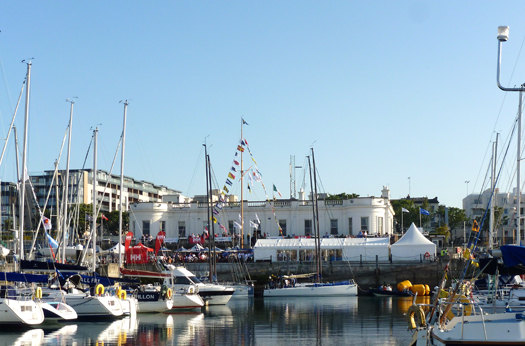
Party time in Dun Laoghaire – the Royal Irish YC during VDLR 2013. Photo: W M Nixon
As for Ireland's classic clinker-built vintage classes, one of the pleasantest surprises in VDLR 2013 was the large turnout of Mermaids, which had superb racing on the course area in the northwest corner of Dublin Bay. Despite having been born as the Dublin Bay SC Mermaid in 1932, this class of 17ft super-dinghies is no longer included in the regular DBSC programme owing to shortage of numbers for weekly turnouts. But it seems that as far as the VDLR is concerned, the Mermaid is now an event boat, and the fleets still thriving at other centres, together with some of the dormant Dublin Bay craft, bestirred themselves for the four days to enjoy good sailing for more than three dozen boats, something which is highly likely to be repeated in 2015.
The even more venerable Water Wags, founded 1887 with the current boats dating from 1903, continue to thrive in Dun Laoghaire, and the word is they expect to have at least twenty boats in action, while another wooden classic, the Mylne-designed 25ft Glen keelboat, is 50 years and more in Dun Laoghaire, and looks forward to having at least twelve boats racing in 2015.
All these specialized and historic classes are in addition to the numerous cruiser-racers which continue to be the backbone of Dublin Bay sailing. And while many of them will see the VDLR 2015 as a highlight of the year, in turning to consider the overall national programme, we find a sport which is shaking off economic recession to get on with an extraordinary plethora of local, national and international sailing events.
The problem is that most events of significance hope to locate themselves in the peak sailing period from late May to early September, so clashes are almost inevitable, and if you're interested in several different kinds of sailing, the overall choices can be bewildering in their complexity and logistical challenges.
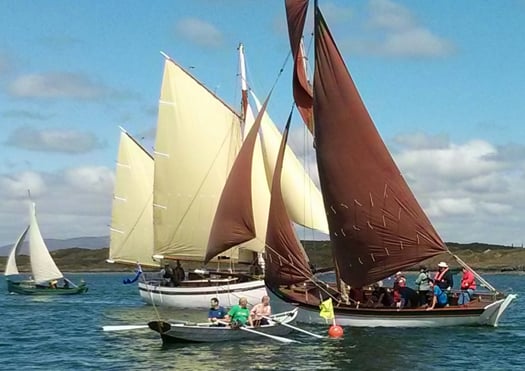
The Baltimore Wooden Boat Festival attracts an eclectic fleet – included here are a Shannon Gandelow, a West Cork Mackerel Yawl, the ketch Sile a Do, and an Heir Island Lobster Yawl (left).
For instance, the variety of events now available for the traditional and classic boats – usually but not necessarily under the Old Gaffer umbrella – would keep anyone busy for most of the summer. It starts with the Baltimore Wooden Boat & Seafood Festival from Friday 22nd May to Sunday 24th May, which you'd think very early
in the season for someone faced with fitting out an old wooden boat in Ireland's climate, but somehow they do it.
Then on the East Coast for the early summer Bank Holiday Weekend from May 29th to June 2nd, there's the Old Gaffer gathering in Dublin Bay at Poolbeg Y&BC with the annual race for the Leinster Trophy in the bay on Saturday May 30th, the event then morphs into the Dublin Port Riverfest in the Liffey on Sunday May 31st, and finally it all concludes with the race for the Asgard Trophy back in the bay on Monday June 1st.
The annual Lambay Race at Howth, a regular fixture since 1904, has seen its course becoming increasingly complex in modern times in order to satisfy the desire of modern racers for competition on every possible point of sailing. But in 2014, to celebrate the Centenary of the Lynch family's Echo, the venerable Howth Seventeens were sent on the traditional course north from Howth Harbour through the sound inside Ireland's Eye, then on round Lambay leaving it to port, and then back south inside Ireland's Eye again to the finish at Howth pierheads.
This was such an attractive proposition for Old Gaffers and Seventeens alike that on the day an extra Classics Division was added to cater for ancient craft, and it hit the spot. This option will be offered again for 2015's Lambay Race (it's on Saturday June 6th), and the word is that Dickie Gomes's 1912-built 36ft yawl Ainmara will be coming down from Strangford Lough to defend her title after 94 years. 94 years? Yes indeed - she won the Lambay Race in spectacular style in 1921 when still under the ownership of her designer-builder John B Kearney.
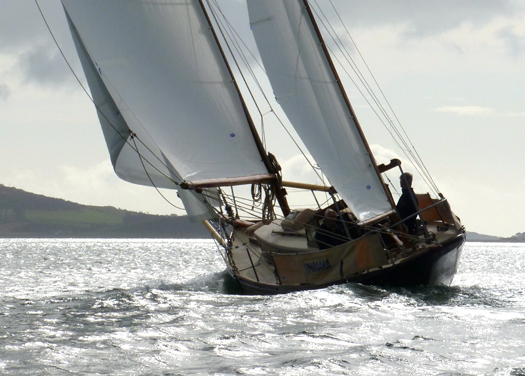
After 94 years, Dickie Gomes's 36ft 1912-built yawl Ainmara (seen here on her home waters of Strangford Lough) hopes to return to defend the title in Howth's Lambay Race, which Ainmara won in 1921 while still in the ownership of her designer-builder John B Kearney. Photo: W M Nixon
The Old Gaffers attention then swings north as the Tall Ships are coming to Belfast from Thursday 2nd July to Sunday 5th July. This is going to be a serious biggie with those ships already signed up including a significant turnout of Class A vessels, which are square riggers and others of more than 40 metres in length. Belfast Lough lends itself particularly well to the Parade of Sail which follows a Tall Ships gathering, and in 2009 when they were last in the port they put in in a virtuoso display with the Dutch ship Europa in particular going to the trouble of getting herself over towards Whiteabbey in the northwest corner of the lough to allow her time get every stitch of sail set before proceeding seawards down-lough in colossal style, a much more impressive display than we've become accustomed to in Dublin, where the shape of Dublin Bay is such that it doesn't really provide the space for square riggers to set all cloth before getting out to sea.
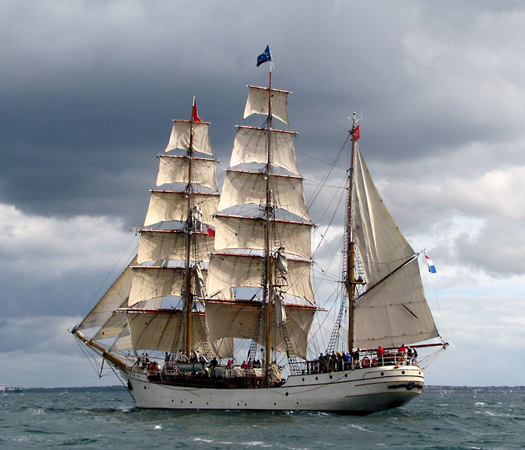
The Tall Ship Europa shows how it should be done in Belfast Lough in 2009, taking time out to set full sail before she starts to gather power to make the proper input into the Parade of Sail.
Like Dublin, Belfast has shown it can be hospitable to Old Gaffers, and it was a very welcoming main port during the OGA Golden Jubilee Cruise-in-Company in 2013, so for 2015 the OGA National President Sean Walsh hopes to up the ante by persuading his members from all round the Irish Sea to gather in Belfast, and to add spice to the mix, he hopes to persuade the Howth 17s to put in an appearance as well, to sail with local one designs like the 1903 Belfast Lough Waverley Class, which have been experiencing a revival in recent years.

Old Gaffers in Belfast for their Golden Jubilee in 2013. The Irish Sea classic and traditional fleet will return to the same venue for the Tall Ships gathering in July 2015. Photo: W M Nixon
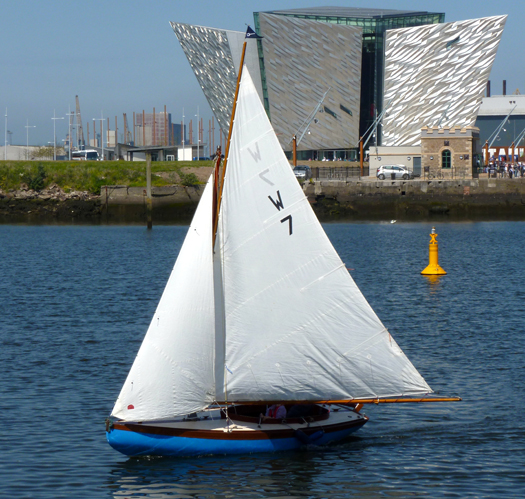
The Belfast Lough Waverley Class Lilias (built 1903) sailing at the Titanic Centre in Belfast. In 2015, the Waverleys will be joined by some of the 117-year-old Howth 17s to participate in the visit of the Tall Ships. Photo: W M Nixon
The Seventeens have made long treks as a class before – in 1998, five of them were road-trailed to Carrickfergus to mark the class's Centenary, with the first five boats built by Hilditch of Carrickfergus. So though they'd trailed there, they then sailed the 90 miles back to Howth, just as the first boats had done a hundred years earlier. Then in July 2003, fifteen of the Seventeens took part in the Glandore Classics Regatta thanks to a brilliantly organised exercise in logistics using a flotilla of low loaders which could take three boats apiece.
For all of Ireland's classic and traditional boats in 2015, and an international fleet too, Glandore is very much up on the radar again, as a special effort is being made by a GHYC team led by Donal Lynch to encourage increased numbers in the CH Marine Glandore Classic Regatta from Saturday July 18th through Friday July 24th. It's a date which certainly allows Old Gaffers plenty of time to get down from Belfast, indeed some may even consider the option of making the voyage northabout to take in a round Ireland cruise while they're at it. And as that great magnet of the Irish Sea classic and traditional scene, the Peel Traditional Boat Weekend, isn't until Friday 31st July to Sunday 2nd August, it's just about possible to factor that in as well.
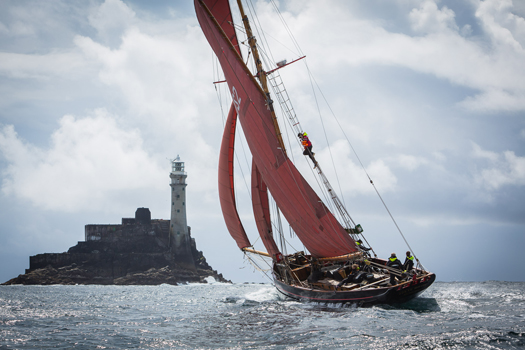
Everything happening at once – the famous Pilot Cutter Jolie Brise was the star of the Glandore Classics in 2013, and as it was her own Centenary she celebrated by sailing round the Fastnet Rock – she has been a successful Fastnet Race participant several times. Photo: Brian Carlin
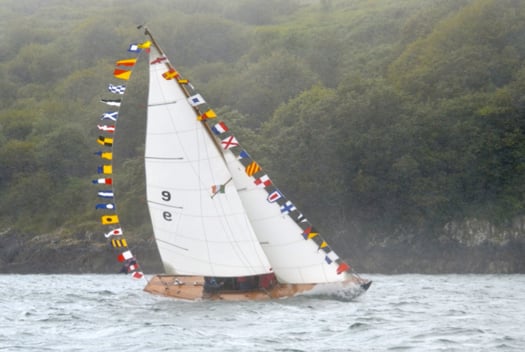
The Glandore Classics attracts an international fleet, and 2013's regatta included a class of Fife One Designs from the Menai Straits, all of them keen to party and showing it. 2015's Glandore Classics is from July 18th to 24th. Photo: Cormac O'Carroll
All this is already happening for the oldies with August barely under way, yet for modern cruiser-racers the potential programme for any keenly-sailed Irish boat is equally complex, attractive and challenging. The season starts as usual with the Scottish Series from Friday 23rd May to Monday 26th May – there'll probably still be snow on the mountains of Arran. They've gone back to their roots by starting with a feeder race from Gourock to the main regatta centre at Tarbert on Loch Fyne. "Going back to the roots" is something of a theme for this year's staging of the Clyde Cruising Club's main racing event, as this is the 40th Scottish Series. Come to think of it, there are so many important 40th anniversaries happening in sailing these days that we have the admit that the decade which brought us the full horror of wide lapels and flared trousers also contributed some lasting elements of the international sailing scene, indeed it could be said that the modern era in sailing really began about forty years ago.
Back in Ireland, the ISORA programme will be well under way by June, while the Lambay Race on June 6th can be looked at with more interest by several boats, as the biennial National YC Dun Laoghaire to Dingle Race doesn't start until Friday June 12th . Last time round, there was a total fixtures clash between the two events, but in times before that hyper-keen sailors such as the Tyrrells of Arklow with Aquelina have been able to fit in both, indeed one year they did it so well they won both too, and were rightly acclaimed as the Afloat "Sailors of the Month" for their success.
For 2015, defending champion in the Dingle Race is Brian O'Sullivan of Tralee with the veteran Oyster 37 Amazing Grace, which came good in the end in 2013 with a new breeze which knocked pending leader Antix (Anthony O'Leary) off the winning perch. But with the 2015 Dingle Race acting as a useful if rather indirect feeder for the Covestone Asset Management Sovereigns Cup in Kinsale from June 24th to 28th, there could be all sorts of sharp boats lining up to take the prize, for the Sovereigns Cup 2015 includes the all-singing all-dancing ICRA Nats 2015.

The welcoming port – Kinsale is one of Ireland's most popular destinations, and in 2015 its hosts the combined Sovereigns /ICRA Nationals from June 24th to 28th.

Perfect sailing – racing in the Sovereigns at Kinsale in June 2013. Photo: Bob Bateman
Yet the timing of the combined Sovereigns/ICRA Nats is such that there's still plenty of time and space to get back to the Irish Sea for the Volvo Dun Laoghaire Regatta 2015 from July 9th to 12th, a reminder that much of the cruiser-racer programme for 2015 is in a neatly balanced and user-friendly timescale for everyone except perhaps those who wish to do either the entire ISORA or SCORA programme as well, so the problem mostly is going to be getting time off work.
And for the hyper-keen cruiser-racers, particularly those whose boats are small enough to be conveniently trailerable, further temptation looms in 2015 with the WIORA Championship at Galway Bay Sailing Club from July 22nd to 25th. For the fleets in the Shannon, on Tralee Bay, and in Clew Bay, it's a bit more than a day's sail away, but they'll be there to challenge Liam Byrne of the home club who won it in 2014 with his Corby 25 Tribal at Mayo SC in Clew Bay, while some top boats from more distant centres are expecting to trail to Galway Bay to spice up the competition.
By this stage of the season a more relaxed pace might be welcome, but the lively turnout of 80 boats in 2014 for the new-style four day Cork Dry Gin Calves Week out of Schull in early August (Tuesday 4th to Friday 7th August in 2015) suggests that for racing sailors, the best relaxation is more racing, but in a holiday setting. And yes, it has been noted that a true West Corkian sailing nut could indeed do all of Calves Week 2015, and still be on the Squadron line for the start of the Fasnet Race nine days later.
For dinghies in 2015, the big story is the debut of the newest version of the National 18, and just how popular will the Bray-bult foiling Moths become, while established classes will frame their programmes to accommodate sailors whose time is limited, also having to fit in with a national scene where the number of Race Officers with the necessary skills is inevitably a finite amount.
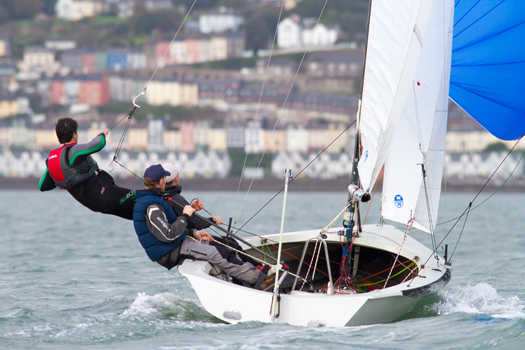
The big stories in Irish dinghy racing in 2015 will be the arrival of the new National 18s at Crosshaven, and the revival of Dinghy Week there in late August. Here, in the Autumn of 2013, To Dwyer and Nin O'Leary test sail the prototype of the new 18 on Cork Harbour. Photo: Bob Bateman
The new Third Generation (or maybe it's fourth or fifth generation) National 18 may have been designed in England by Phil Morrison, and is being built there too. But it was the very active Crosshaven fleet with the Royal Cork Yacht Club which led the charge towards a new boat, and when it came to stepping up to the plate to pay twelve substantial new boat deposits to move it all along after the prototype had been rigorously tested in Cork harbour last Autumn, it was the Crosshaven fleet that provided eight out of those twelve cheques.
So it's entirely appropriate that in August 2015, the dinghy focus will swing big time towards Crosshaven and a short form "Dinghy Week" from August 21st to 23rd. The old style Irish Dinghy Weeks – the last one was in 1970 – became victims of their own success, they just got too large. But the different classes became over-optimistic about their continuing individual growth prospects. Then the pendulum swung too far the other way, and dinghy classes were alone and their events shrinking. But a resurgence of club and championship dinghy sailing in Crosshaven during 2014, and a growing realization that over-reliance on single-handed dinghy classes does not necessarily produce a socially-adjusted national squad of junior sailors, resulted in some clear and creative thinking about developing two-handed boats, and reviving some old classes such as the Mirrors.
The form of this new Dinghy Week is still in the melting pot, but at least eight classes have responded with enthusiasm. Meanwhile, the National 18s in Crosshaven will be such a focus of interest during 2015 with the first of the new boats making their debut that we'll have a season-long dinghy narrative developing on Cork Harbour, and the revived Dinghy Week will be just part of it.
As for inshore keelboats, the big one in terms of number is the combined British and Irish Championship Squib Championship at Howth from 27th June to 3rd July. The handy little Squibs are something of an oddity, as they serve so well as a cherished local class in so many Irish sailing centres that many owners see them as that, and nothing more – handy little club sailors to be raced on home waters a couple of times a week.
This means that when a major regional or national event is held, the number taking part will often only be a fraction of the total Irish Squib fleet. But for those who do make the trek, the competition is fierce and the racing great – in Howth, the high point was in 1996, when this "Nationals" event attracted a fleet of exactly a hundred boats, and on one never-to-be-forgotten morning, there they were, every last one of them on the starting line.

A hundred Squibs all in a row at Howth on Tuesday July 25th 1996. Photo: Mandy Murnane
The most recent Squib event of national stature was the Freshwater Keelboat Regatta at Dromineer on Lough Derg on the weekend of October 18th-19th, and the battle for the top places was between the Kinsale and Belfast Lough fleets, with James Matthews and Rob Jacob of Kinsale rounding out their year in style with a good win.
But with the Squibs in England undergoing a revival – they were the second-biggest One Design fleet in Cowes Week 2014, bested only by the legendary XODs – there's no doubt there's a strong challenge coming across channel, and any Irish boat getting into the top ten will be doing well.
As for that annual Autumn Freshwater Keelboat Regatta at Dromineer, while it may have been much hampered by the spinoff from some ferocious weather out in the Atlantic with frustration for some of the sixty boats hoping to take part, it's an event of enormous potential, and the many who wish it well and have enjoyed it in the past will be ready and willing to do their part to make 2015's regatta a success.

The Squibs enjoying a lull in the strong winds during the Lough Derg Freshwater Regatta 2014. Overall winner was Mucky Duck (no 51, James Matthews & Rob Jacob, Kinsale YC). Photo: Gareth Craig
All these specialised and localized events planned for 2015 will be the continuing background music to the usual events of national sailing focus, everything from the selection of the Irish team for the Student Yachting Worlds to the Helmsmans Championships to the steady increase in pace while 2015 develops as the pre-Olympic year. As the year rolls along, other stories will develop too. So perhaps it's appropriate that we exit this review as we entered it. Just pause to remember now and again that, a hundred years ago, you simply couldn't have gone freely afloat like this for sport and recreation at all.
But we can't close on such a solemn note. Seasoned Solent sailors may have noted our header photo from Guido Cantini at the Panerai Classics Regatta was looking just slightly odd, for some reason difficult to pin down. Well, as it happens, the photo was sent to us back in September just as we were contemplating the excellent cleanup up done by Jason Hurley of Jason Hurley Design on the Mercedes-sponsored billboard photo of Howth 17s on the end wall of Howth Yacht Club. As with many photos taken over the RYS starting cannons, the Cantini pic included an obtrusive part of the Fawley Oil Refinery across on what Isle of Wight people call "the north island". Though Fawley has been there for yonks, it still has the look of a temporary structure. So we got Jason to treat as just that. But here for your edification is the true picture. You could get a taste for this sort of thing. What about brushing out Whitegate, lads? And as for Milford Haven.........
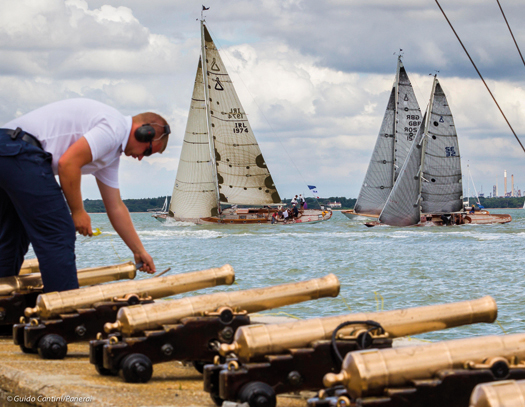
The unvarnished truth. In real life, the view from the RYS battery at Cowes can be slightly marred by the clutter of Fawley Refinery across the Solent on "the north island". Photo: Guido Cantini/Panerai
Read also: 2015 Irish Sailing Fixtures List (provisional)
Glen Keelboat Class Fleet Celebrate Fifty Years of Sailing
#glensailing – The Glens are celebrating 50 years sailing and racing together as a class in Dublin Bay Sailing Club, writes 'Glenshane' skipper Pete Hogan. As a very successful season draws to a close for the 12 or so Glens in Dublin Bay there seems all prospects that the fleet can continue for a further 50 years.
The story of the Glens is worth repeating. Designed by the celebrated Scottish Marine architect Alfred Milne in 1945 the Glens were built by the Bangor boatyard over the following 20 years. Possibly 39 Glens, at least, were built which gives them claim to be Milne's most successful design and also one of the last of Alfred Milne Senior's designs. The firm still exists. He also designed the Dublin Bay 21's and the 24's which were recently in the news on Afloat.ie
At first the Glens were confined to the North but started appearing in Dublin over 50 years ago. Glenluce G67 celebrated last year being 50 years in the sole ownership of the O'Connor family. They started racing together as a class under DBSC organisation in 1964 and have been racing ever since.
Glens are classic little yachts, retaining their looks up to today as reminders of what sailing boats looked like before the era of plastic mouldings, high freeboards and self-draining cockpits. 25 ft. long with a full keel and sensible sail plan they represent state of the art pocket cruisers of the period.
Glens were often compared to Dragons. They are heavier, shorter and carry a bit more sail. But they were never allowed to become the development class which the Dragons became and never made the seismic shift into fibreglass construction. Their handy size however, has allowed them to survive just as the 17's in Howth survive and thrive. There is a mini wooden boat building fraternity centred on the Glens and their needs. The Brennan boatbuilding family in Dun Laoghaire, all three generations of it, being its mainstay.
Moored out in front of the Royal St George YC and each painted a distinctive different colour, the Glens have become as iconic a fixture in Dun Laoghaire as the bandstand, Teddy's ice cream shop or the fishermen casting their lines from the pier. Long may they continue.
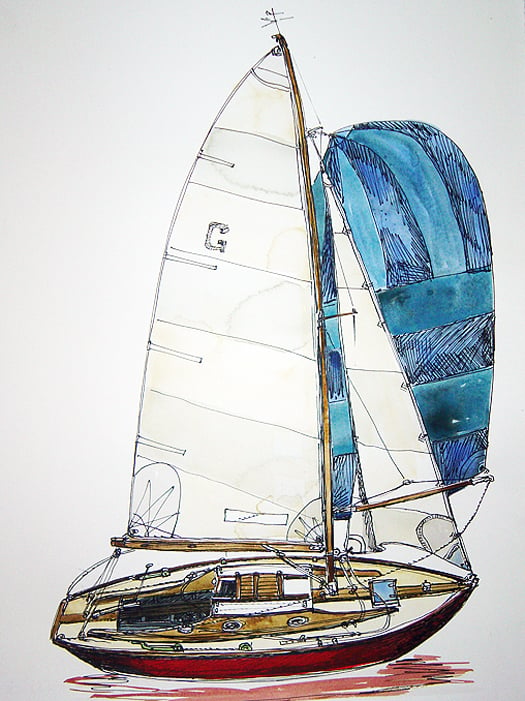
The Glen keelboat. Illustration by Pete Hogan
Anyone interested in getting involved in the Glen Class in Dublin could contact Pete on 087 930 9559 or click HERE



























